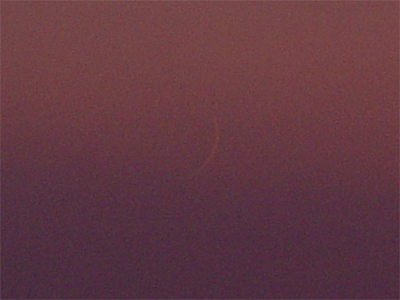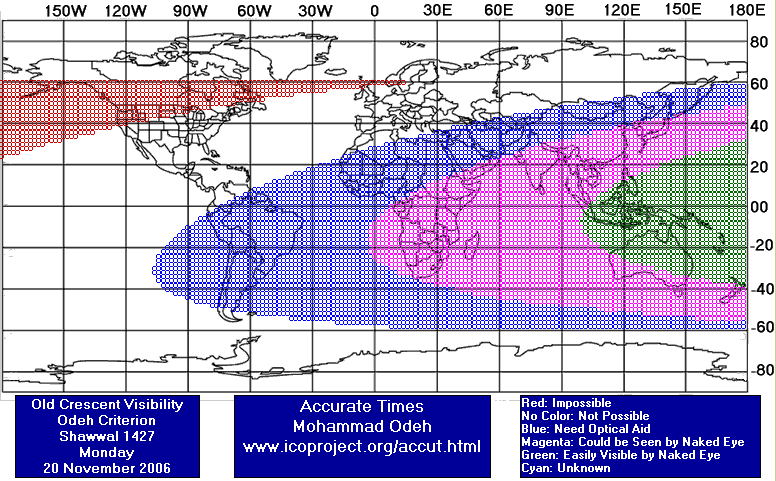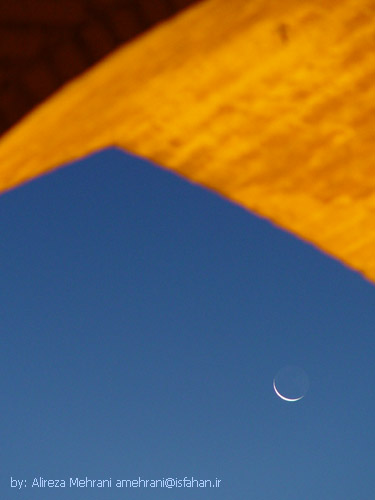Visibility of Thul Keadah Crescent
(1427 AH)
- When to Observe Thul Keadah Waxing (NEW) Crescent ?
- Thul Keadah Waxing (NEW) Crescent Observation Results
- The OFFICIAL First Day in Different Countries
- When to Observe Shawwal (OLD) Crescent ?
- Shawwal Waning (OLD) Crescent Observation Results
The geocentric conjunction (Geocentric New Moon) will occur Inshalla on (Monday 20 November 2006) at
22:18 UT.
Sighting the new crescent on (Tuesday 21 November 2006) is shown in the below graph using the program Accurate Times by Mohammad Odeh according to Odeh criterion. Where:-
According to the actual sighting of the crescent, the start of Thul Keadah should be on Wednesday 22 November 2006 in most parts of the world.
- Results of seeing the crescent, and the first day of the month in different countries will be added here Inshalla as we receive the reports from ICOP's members. If you wish to be a member in ICOP, or to know more about it, kindly click here.
So far, the earliest sighting of the crescent was on Tuesday 21 November 2006 by ICOP member Mr. Jim Stamm from Tucson, Arizona (USA).
Tuesday 21 November 2006:
Wednesday 22 November 2006:
Wednesday 22 November 2006:
Thursday 23 November 2006:
The geocentric conjunction (Geocentric New Moon) will occur Inshalla on (Monday 20 November 2006) at
22:18 UT.
Sighting the OLD crescent on (Monday 20 November 2006) is shown in the below graph using the program Accurate Times by Mohammad Odeh according to Odeh criterion. Where:-
When to Observe Thul Keadah Waxing (NEW) Crescent ?


Thul Keadah Waxing (NEW) Crescent Observation Results
New Moon Crescent Observation Report
===============================
November 2006
Location = Tucson, Arizona (USA)
Longitude = 111° 06’ W
Latitude = 32° 13’ N
Elevation = 961 meters
Time Zone = -7.0 hours
Surface conditions at time of first sighting at
Tucson International Airport (805 m):
Temperature = 26 degrees Celcius
Relative Humidity = 16 percent
Atmospheric Pressure = 1017 mb
Topocentric and local time values from “Accurate Times”:
Sunset (at sea level) = 17:26
Moonset (at sea level) = 17:50
Time from new moon at 17:37 = 25 hr. 09 min.
Moon lag time = 25 minutes
Relative Altitude = 4.49 degrees
Elongation from sun = 13.34 degrees
Crescent width = 25 arcseconds
Illumination = 1.36 percent
Crescent first observed through 8” SC telescope:
Time = 17:30
Altitude = 01.8 degrees
Final observation with telescope:
Time = 17:37
Altitude = 00.6 degrees
The image was too tenuous to measure the arc length precisely,
but it was about 60 degrees.
There were attempts to sight the crescent with binoculars before
and after sighting through the telescope, but the image was too
feeble for binoculars.
Observer(s):
Jim Stamm
John Polacheck

Location: Esfahan, Iran (32:37N 51:35E)
Time Zone: +3.5
Observer & photographer: Alireza Mehrani
Time: 17:28 LT
Moon Alt: 3.20d
Elongation: 19.5d
Width: 0.88m
Arc Length: 135d (from 1.5 to 6)
PS: The western horizon was cloudy and hazy.

- First seen with binocular at 16:39
- Sun disc disappeared at 16:46 (5 minutes before our local sunset)
- Sunset at 16:51
- Diappeared behind dark cloud : unfortunatly did not register the time
- Then seen directly with naked eyes below that cloud 17:23
- Last seen with naked eyes behind a horizon touching cloud : 17:28
- Last seen with bino 17:29 ( thats 18 minutes before moonset time )
- Moonset at 17:47 .
- The sky was very clear exept from low cloud above western horizon and little pollution from doha power station and haze at - The last 3 degrees above the horizon . "

The OFFICIAL First Day in Different Countries

When to Observe Shawwal Waning (OLD) Crescent ?







